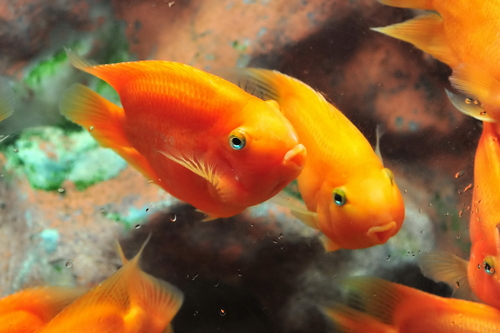There are few cichlids in the fish family that are as vibrant and fun to watch as the blood parrot cichlid. With that being said, you wouldn’t want to make your fish unhappy by pairing it with incompatible tank mates. Let’s look over our list of the 15 best blood parrot tank companions!
The best tank mates for Blood Parrot cichlids are normally from cichlids that are similar in size to avoid infighting. Fish who are able to survive in similar environments, but are not easily bullied nor much smaller than the blood parrot cichlid also make good tank mates.
In this article, we will not only share our list, but the answers to some frequently asked questions on the topic!
Contents
Blood Parrot Tank Mates – What You Need to Know
Below are some of the most important things to take note of about your Blood Parrot cichlid.
Temperament
A blood parrot cichlid is not like most of it’s cichlid family members because it is not as inherently aggressive. They are typically gentle and high in energy, provided with enough room and territory of their own.
With that being said, a Blood Parrot cichlid should not be kept with fish that are large and overly aggressive, especially not in tight places!
Size
If one fish is significantly larger than the other, some infighting may occur. However, another issue to worry about is the size of your tank. If your blood parrot cichlid is kept in a tank which is too small, don’t wonder why there isn’t peace in the aquarium! A blood parrot cichlid usually grows to about 8 inches long.
Competition
When two or more fish tend to feed on the same type of food, they can get into a cycle of trying to beat one another to food sources at meal time. If you aren’t careful, this could cause shier or more submissive fish to actually die of starvation.
The Blood Parrot Cichlid eats food pellets specifically designed for cichlids, so you’ll need to make sure any cichlid tank mates are being fed at alternating times or are not competing too aggressively for food.
Parameters ; Tank Setup
A blood parrot cichlid needs slightly acidic, warm water to survive. The temperature should be between 76 degrees Fahrenheit and 80 degrees Fahrenheit. It will also be most happy with a pH range between 6.5 and 7.4. Be sure to find tank mates with similar setup requirements for the happiness of all included!
15 Best Blood Parrot Cichlid Tank Mates
It’s time to go over our list of the very best Blood parrot tank mates below!
- Neon Tetras
- Angelfish
- Zebra Danios
- Bristlenose Pleco
- Pygmy Corydoras
- Giant Gourami
- Ram Cichlids
- Clown Loaches
- Rainbow Kribs
- Rosy Barb
- Giraffe Catfish
- Mbu Puffer
- Clouded Archerfish
- Golden Severum
- Tiger Barb
We’ll go over each fish in more detail below.
Other similar posts you don’t want to miss:
1. Neon Tetras
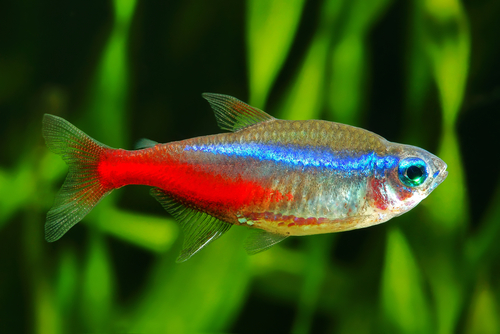
- Scientific Name: Paracheirodon innesi
- Adult Size: 1.5 inches
- Compatible With: Blood Parrot Cichlid
- Water Temperature: 69 to 79 F
- Minimum Tank Size: 10 Gallons
- Care Level: Medium Difficulty
- Origin: Southeastern Colombia, Eastern Peru, Western Brazil
If you’re a lover of flashy fish and need more variety to go with the bold color of your blood parrot cichlid, look no further than the Neon tetras! This fish is gentle and has the bonus effect of cleaning up detritus at the bottom of the tank.
Pros of keeping with Blood Parrot Cichlid:
- No aggression
- No food competition
- Cleans up the bottom of the tank
Cons of keeping with Blood Parrot Cichlid :
- None!
2. Angelfish

- Scientific Name: Pterophyllum
- Adult Size: 6 inches
- Compatible With: Blood Parrot Cichlid
- Water Temperature: 75 to 82 F
- Minimum Tank Size: 20 gallons
- Care Level: Easy
- Origin: South America
An angelfish is not only beautiful for it’s brightly colored eye and stripes, but it has the added benefit of being a contrast in shape to the rounder cichlid. It will also not bother your cichlid with bullying or too aggressive an amount of competition.
Pros of keeping with Blood Parrot Cichlid:
- Not aggressive toward the blood parrot cichlid.
Cons of keeping with Blood Parrot Cichlid :
- May be aggressive with others of its own kind.
3. Zebra Danios
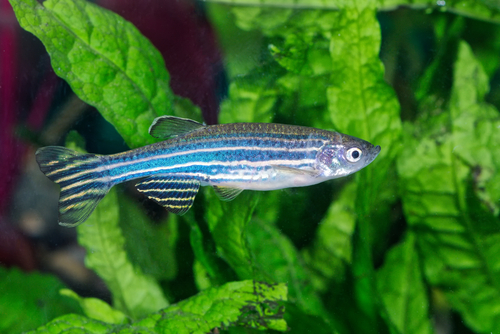
- Scientific Name: Cyprinidae
- Adult Size: 2 inches
- Compatible With: Blood Parrot Cichlid
- Water Temperature: 64 to 74 F
- Minimum Tank Size: 10 gallons
- Care Level: Easy
- Origin: India
The thing that makes the zebra danios so great for a blood parrot cichlid is not simply their pleasing striped, monochromatic looks. It is also not the fact that zebra danios are fun to watch in a school. It is simply the fact that they are peace lovers, and will not gang up on the more peaceful cichlid!
Pros of keeping with Blood Parrot Cichlid:
- Non aggressive
Cons of keeping with Blood Parrot Cichlid :
- None!
4. Bristlenose Pleco
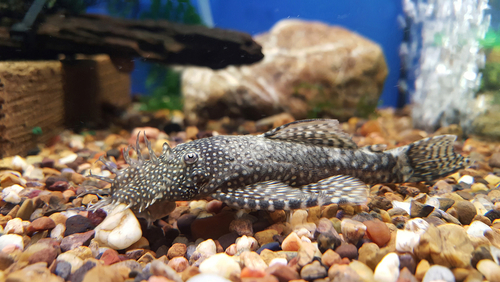
- Scientific Name: Ancistrus Cirrhosus
- Adult Size: 5 Inches
- Compatible With: Blood Parrot Cichlid
- Water Temperature: 73 to 81 F
- Minimum Tank Size: 40 Gallons
- Care Level: Easy
- Origin: Amazon Basin
This sweet, droop-faced fish has a pleasingly speckled coloration that will contrast well with the Blood Parrot cichlid. It is also perfectly fine to exist in a zone of its own, which it may be territorial over; however, since the Blood Parrot cichlid is non-confrontational, this will not lead to fighting!
Pros of keeping with Blood Parrot Cichlid:
- Eats a large variety of foods for lack of food competition.
- Will not often fight with a Blood Parrot cichlid.
Cons of keeping with Blood Parrot Cichlid :
- None!
5. Pygmy Corydoras
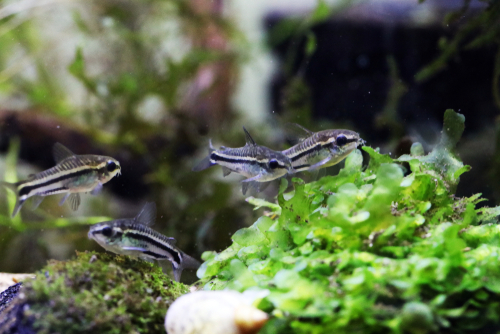
- Scientific Name: Corydoras pygmaeus
- Adult Size: 2 inches
- Compatible With: Blood Parrot Cichlid
- Water Temperature: 68 to 77 F
- Minimum Tank Size: 10 Gallons
- Care Level: Easy
- Origin: Peru
A non-aggressive fish, happy to swim peacefully around the Blood Parrot cichlid. It eats during the nighttime, and so it will not be in competition with your cichlid. In fact, the Blood Parrot cichlid may find itself perfectly happy as long as it has several of it’s own kind in the tank along with the Blood Parrot Cichlid!
Pros of keeping with Blood Parrot Cichlid:
- Non Aggressive
- No Food competition
Cons of keeping with Blood Parrot Cichlid :
- May need 10 other Corydoras to feel safe!
6. Giant Gourami

- Scientific Name: Osphronemus Goramy
- Adult Size: 18 to 28 inches
- Compatible With: Blood Parrot Cichlid
- Water Temperature: 82 F
- Minimum Tank Size: 200 Gallons
- Care Level: Easy
- Origin: Southeast Asia
Though this tank mate may need a big amount of space and food, it will be completely non-aggressive toward your blood parrot cichlid. This is provided it has enough room. In the meantime, you can enjoy how this fish morphs in shape while growing!
Pros of keeping with Blood Parrot Cichlid:
- Non-aggressive!
Cons of keeping with Blood Parrot Cichlid :
- None!
7. Ram Cichlids
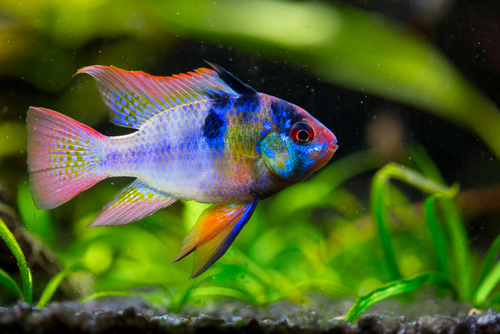
- Scientific Name: Mikrogeophagus ramirezi
- Adult Size: 2 to 3 inches
- Compatible With: Blood Parrot Cichlid
- Water Temperature: 74 to 82 F
- Minimum Tank Size: 20 gallons
- Care Level: Difficult
- Origin: South America
This cichlid may not have the aggressive tendencies that others of it’s species do, much like the blood parrot cichlid, but it is a little more difficult to care for than most. For one thing, it needs a large tank. For another, this species needs plants and caves to hide behind.
Pros of keeping with Blood Parrot Cichlid:
- Non-aggressive
- Occupies a different tank zone, near the bottom.
Cons of keeping with Blood Parrot Cichlid :
- Difficult to calculate correct water conditions
- Requires a larger tank.
8. Clown Loaches
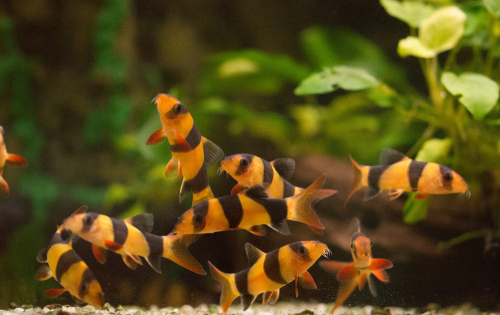
- Scientific Name: Botia macracantha
- Adult Size: 12 inches
- Compatible With: Blood Parrot Cichlid
- Water Temperature: 75 to 85 F
- Minimum Tank Size: 100 gallons
- Care Level: Medium Difficulty
- Origin: Indonesia
Clown Loaches are kept in a school of playful, fun-to-watch friends of their own kind. Though they do like to play tag and engage in high energy swimming, they are not a threat of bullying for your blood parrot cichlid, and also unlikely to compete too fiercely for food.
Pros of keeping with Blood Parrot Cichlid:
- Not aggressive
- Not overly competitive
Cons of keeping with Blood Parrot Cichlid :
- None
9. Rainbow Kribs

- Scientific Name: Pelicachromis pulcher
- Adult Size: 3 to 4 inches
- Compatible With: Blood Parrot Cichlid
- Water Temperature: 77 to 75 F
- Minimum Tank Size: 20 Gallons
- Care Level: Easy
- Origin: Africa
Another of the cichlid species, this one with many different names, the rainbow kribs is a peaceful outlier among the usual bullies of its kind. It is also lovely, with a contemplative expression and a pattern of stripes and spots on each fin.
Pros of keeping with Blood Parrot Cichlid:
- Not aggressive
Cons of keeping with Blood Parrot Cichlid :
- None!
10. Rosy Barb
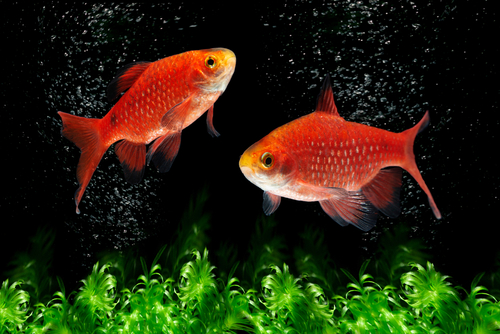
- Scientific Name: Puntius conchonius
- Adult Size: 6 inches
- Compatible With: Blood Parrot Cichlid
- Water Temperature: 64 to 72 F
- Minimum Tank Size: 30 Gallons
- Care Level: Medium Difficulty
- Origin: India, Bengal
Rosy Barbs are not only a beautiful fiery color, but they are a fantastic fish when it comes to community. They are only aggressive, nipping at tank mate fins, if stressed. The best way to keep your rosy barb from engaging in this behavior with zebra danios is to keep the schooling barb with five or more of its own kind.
Rosy Barbs will match the bright red of your blood parrot cichlid beautifully. They also make excellent community fish as long as they are not kept without some of their own kind. When stressed out, they tend to bite other fish. To keep them mellow with your cichlid, all you need is more than two rosy barbs together!
Pros of keeping with Blood Parrot Cichlid:
- Not normally aggressive
- No food competition
Cons of keeping with Blood Parrot Cichlid :
- Will become aggressive when left without more of its own kind.
11. Giraffe Catfish
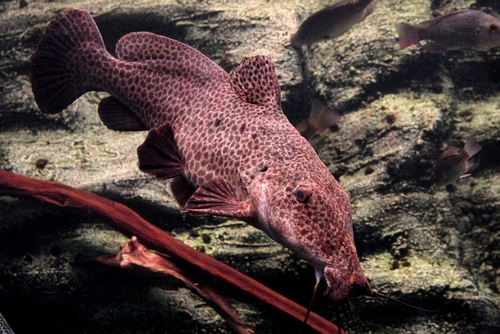
- Scientific Name: Auchenoglanis occidentalis
- Adult Size: 20 to 28 inches
- Compatible With: Blood Parrot Cichlid
- Water Temperature: 75 to 82 F
- Minimum Tank Size: 180 gallons
- Care Level: Medium Difficulty
- Origin: Africa
This long, loach-like catfish is a delight to watch along the bottom of the tank. As long as this species of catfish is kept apart from any fish that are too small or young, as well as eggs, the giraffe catfish will not pose a threat to your blood parrot cichlid.
Pros of keeping with Blood Parrot Cichlid:
- Not typically aggressive
Cons of keeping with Blood Parrot Cichlid :
- Needs a large tank
- Should not be kept with adolescent blood parrot cichlids.
12. Mbu Puffer
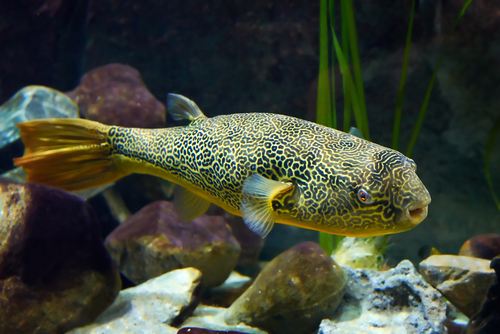
- Scientific Name: Tetraodon mbu
- Adult Size: 30 inches
- Compatible With: Blood Parrot Cichlid
- Water Temperature: 74 to 80 F
- Minimum Tank Size: 500 gallons
- Care Level: Easy
- Origin: Tanzania, Zambia, Cameroon
The Puffer is a great way to add visual diversity to your tank. Plus, their cute faces are a pleasing bonus! They also aren’t likely to bother your blood parrot cichlid. However, this is a large fish, and needs a pretty huge tank, especially when kept with other fish.
Pros of keeping with Blood Parrot Cichlid:
- Not aggressive
Cons of keeping with Blood Parrot Cichlid :
- Requires a Very Large tank.
13. Clouded Archerfish

- Scientific Name: Toxotes Blythii
- Adult Size: 6 inches
- Compatible With: Blood Parrot Cichlid
- Water Temperature: 76 to 84 F
- Minimum Tank Size: 50 gallons
- Care Level: Medium Difficulty
- Origin: Burma
This fish has a squat body with shiny silver and black coloration. It is semi-aggressive, but the good news is, with a large enough Blood Parrot cichlid and a large enough tank, there should not be much infighting.
Pros of keeping with Blood Parrot Cichlid:
- Too small to be overly aggressive.
Cons of keeping with Blood Parrot Cichlid :
- Can be aggressive if paired with a Blood Parrot Cichlid in too close a space.
14. Golden Severum

- Scientific Name: Heros Severus
- Adult Size: 10 inches
- Compatible With: Blood Parrot Cichlid
- Water Temperature: 75 to 82 F
- Minimum Tank Size: 50 gallons
- Care Level: Medium Difficulty
- Origin: South America
If you’re looking for a fish that contrasts in style with the blood parrot without looking too crazy, the Golden Severum is for you! Though it is sometimes aggressive, with enough obstacles in the form of plants in the tank, and plenty of room, it should not bother the more peaceful Blood Parrot.
Pros of keeping with Blood Parrot Cichlid:
- Not aggressive, provided enough obstacles.
Cons of keeping with Blood Parrot Cichlid :
- Can become aggressive without enough space.
15. Tiger Barbs
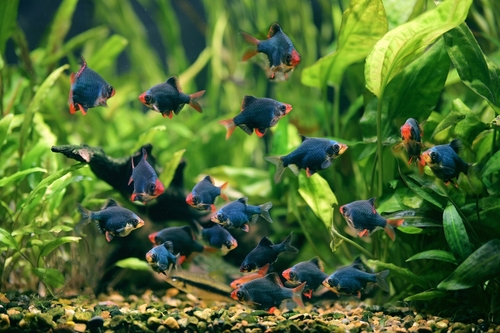
- Scientific Name: Barbus tetrazona
- Adult Size: 3 inches
- Compatible With: Blood Parrot Cichlid
- Water Temperature: 68 to 79 F
- Minimum Tank Size: 20 gallons
- Care Level: Easy
- Origin: Borneo, Sumatra, Indonesia
Tiger barbs are fun to watch in a school, especially if they are paired with other barbs or even clown loaches! That being said, it is no bad neighbor for a blood parrot cichlid, either, because it is peaceful in nature. Make sure that tiger barbs have more than 5 of their own kind in the tank, or they will entertain themselves by getting aggressive with other fish.
Pros of keeping with Blood Parrot Cichlid:
- Not normally aggressive
Cons of keeping with Blood Parrot Cichlid :
- Can become aggressive if left with fewer than 6 of its own kind.
In Conclusion
To sum it all up, the 15 best Blood Parrot tank mates are able to survive in similar tank conditions to the cichlid itself. At the same time, they are not likely to nip or bully the blood parrot cichlid, which is a non-aggressive fish. For this reason, fish like the Mbu Puffer and Rosy barbs are excellent tank mates for a blood parrot cichlid!
However it should be noted that not all of the 15 tank mates are necessarily compatible with one another either, so do your research accordingly when putting together your list of compatible tank mates.
Frequently Asked Questions
How many blood parrot fish should you keep together?
As long as you make sure your blood parrot fish has enough room in the tank, you can have three to six at once!
What fish can you put with a parrot fish?
Parrot fish need to be kept with other fish that need the same temperatures and conditions in the tank as themselves, such as tetras, cory catfish, and plecos. They should not be kept with aggressive, larger species.
Can blood parrots go into a community tank?
Yes, the friendly and affable blood parrot fish can go into a community tank as long as more aggressive species, including other types of larger cichlids, are present.

Veteran fish keeper and keen hobbyist with a serious case of MTS. My midlife crisis was the establishment of a fish room, much to my wife’s horror. Little does she know it could be worse!!


